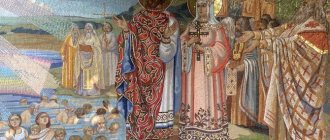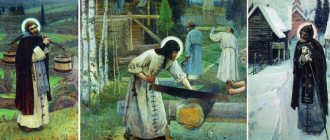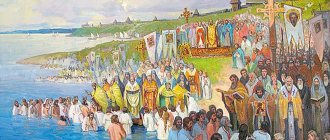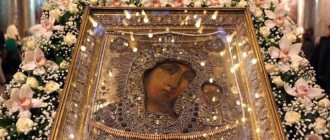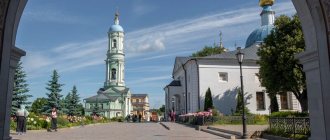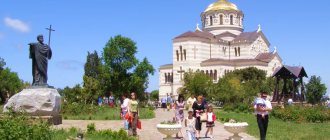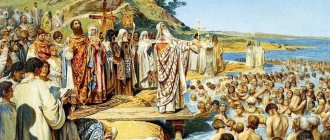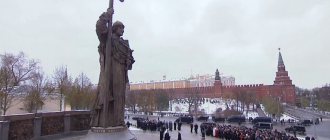- Reports and messages
- Story
- Baptism of Rus'
For many years, the entire territory of Kievan Rus supported paganism.
The mentality of all Slavs was built solely on the contradiction between good and evil. The Slavs honored and worshiped a whole pantheon of gods. They worshiped such gods as Stribog, Perun, Veles and many others. Those times were difficult; the state had to strengthen its position in the international arena. For this, Kievan Rus had to accept Christianity. Many chronicles of that time, especially the Tale of Bygone Years, describe the entire process of the adoption of Christianity by the Russian people. Christianity began with the adoption of faith by Prince Vladimir. He was inspired by the beauty of Byzantine temples, but most importantly he was looking for allies. It is believed that the Byzantine emperor, represented by Kievan Rus, was also looking for new allies. He promised that he would marry his sister Anna to Prince Vladimir, but for this he had to convert to Christianity. From such an alliance both Byzantium and Kievan Rus were supposed to benefit. New opportunities and prospects for future economic growth opened up for the Russian lands. Thus, in 988, Grand Duke Vladimir gathered people on the banks of the Dnieper. Byzantine priests who arrived specially performed the baptismal ceremony for the population. It was a voluntary process that dragged on for many years. Having accepted the new faith, people continued to follow the old canons and worshiped polytheism. It was difficult for them to change their beliefs so quickly. First, close merchants and boyars were baptized, and then ordinary people began to be baptized.
It is believed that Princess Olga was the first to bring Christianity to Russian soil. Back in 955, she converted to Christianity and was baptized. She was baptized according to all the canons of Christianity in Constantinople itself. After Olga's death, her son Svyatoslav returned the veneration of the old gods, the cult of paganism flourished longer. Only Svyatoslav’s son, Vladimir, decided to follow in his grandmother’s footsteps. He, like Olga, turned to Christianity. The adoption of the new faith greatly changed the life and position of the Russian lands. Kievan Rus began to lay claim to relations with European countries. After the baptism of Rus', a gradual abandonment of paganism and everything connected with it began. A new Christian era began in the state.
At this very time, temples and churches were being built in the state and in many large cities. Thanks to the charter adopted by Prince Vladimir, almost all metropolitans and priests received greater rights. They became honorable and respected people. Although, if you do not take into account the fact that most of the territories of Kievan Rus were already under the rule of Christianity, the life situation of ordinary people has not changed. People still continued to honor and adhere to many pagan traditions. Over time, these same traditions were adapted to Christianity. The result was some kind of confusion, where Russian Orthodoxy, somehow, began to combine notes of Christianity and Slavic paganism. Many holidays were fundamentally associated with paganism. Even today, we celebrate spring holidays, and some winter ones, without even thinking about the fact that this is a cross between Christianity and paganism. Of course, the adoption of Christianity by Kievan Rus gave impetus to the veneration of one God. The system of beliefs and worship changed. But the essence remained the same, people continued to believe in something and pray to someone.
What date is the Baptism of Rus' celebrated?
The specific date on which the baptism of Vladimir or the population of Kyiv took place has not survived to this day. Therefore, the baptism of Rus' is usually celebrated on the day of memory of Prince Vladimir (i.e., on the date of his death). This happened on July 15 according to the Julian calendar. Translated into the modern calendar, this date falls on July 28, and it was officially determined by law relatively recently (May 31, 2010). Considering that today this is a memorable date and is not a public holiday, then, accordingly, a day off on this day is not provided.
Story - conversation “Vladimir and the Baptism of Rus'” material on the topic
Conversation: Vladimir and the Baptism of Rus'.
By the 10th century, many peoples and states surrounded Rus'. Many ambassadors came to Kyiv-grad, each praising his land and his faith. However, Vladimir remembered the stories of his grandmother, Princess Olga, about the beauty of Byzantine churches.
The prince thought deeply about a single faith for the entire Russian land. It cannot be said that Vladimir did not love his Russian gods. Back in 980, on a high mountain in Kyiv, he collected all the pagan idols and made the place revered. However, the more the prince looked at his wooden gods, the more often he doubted their strength. He then decided to invite ambassadors from all lands to Kyiv to hear about their faith and decide what would be most dear to Rus'.
Slide No. 1
First, envoys from the people who worship the Prophet Muhammad came to Vladimir. They call their faith Islam. The ambassadors told the prince that according to their faith, one must honor God, not eat pork, not drink wine, in order to begin to live for one’s pleasure in paradise. Vladimir listened to them, said nothing, but decided himself: “What kind of joys are these after death? It’s better to live your life in fun.”
Then those who were called Germans in Rus' because they did not understand their language, that is, Catholics, turned to Vladimir. However, Vladimir did not like them either: there was too much severity in their story, they did not so much praise their faith as they scolded the Russian pagan gods.
Afterwards, the Khazar Jews arrived to the Kyiv prince. The prince asked them: “Where is your land?” The Jews cried and said that God was angry with them and resettled their people all over the world. Vladimir was saddened by this answer, because he did not want to let Rus' spread around the world.
Slide No. 2
In the end, a Greek sage came to Vladimir and spoke about the Orthodox faith. The prince liked his words more than all the speeches; everything here was suitable for Rus'. But Vladimir did not immediately decide on this faith. He gathered his faithful squad, boyars and merchants, and ordered them this way: “Go to different lands and see everything for yourself, and then come back and report who keeps their faith and honors God.”
Ten of the best husbands set off around the world and returned back exactly a year later. The boyars said about Muslims that “there is no joy in them, and that is why their law is not good.” About Catholics - “they didn’t see any beauty.” Only Orthodoxy appealed to the boyars: there is fun in it, joy, and beauty. And the Orthodox people also love feasts and holidays, just like those organized at the court of Prince Vladimir.
This is what the Greek envoy told Vladimir.
He told the Kyiv prince how many years ago, on the outskirts of the Roman Empire, a boy was born who was named Jesus. Then no one knew that it was he who would be destined to change the world, to cleanse the souls of people from evil. Only the wise shepherds, seeing how a new star lit up in the sky over Bethlehem, understood that this was a sign, that is, a sign: the Savior - the Messiah - had come into the world.
Video clip for children “The Nativity of Christ”
Jesus Christ performed many good deeds and miracles in his short earthly life: he raised the dead, healed the lame, and gave sight to the blind. And everywhere, together with his 12 disciples, he preached goodness and mercy, asked people to stop doing evil to each other and committing sins.
Jesus knew that he would have to accept death in order to pay for the sins of the human race: he was threatened with a martyrdom - to be crucified on the cross, but He was not afraid of suffering.
At the age of 33, Jesus’ earthly life was interrupted; He died on Mount Golgotha. This happened on Good Friday, and three days later He rose again. That’s how they called this day of the week – Sunday.
Since then, majestic temples in honor of Jesus Christ have been built throughout all Christian lands. The best artists paint icons. And such power lies in these images that it is not for nothing that they are called miraculous. A Christian will enter under the arches of the church, light a candle, pray to God, and grace will descend upon him - the divine light of truth and forgiveness.
I.K. Pimenova, I.N. Rassokh, I.M. Solomadina, N.A. Solomadina. History of mankind. The Birth of Rus': A Guide for Developmental Education. – M.: ZAO Publishing House Eksmo-press, 1998
The baptism of Rus' by Prince Vladimir, a brief history
Before Kievan Rus adopted Orthodoxy, the Russians were pagans. And attempts to systematize religion were unsuccessful, since it was impossible to create a structure that would unite the rituals and customs of all tribes.
It should be said that even before the official baptism in Rus', the seeds of Orthodoxy began to sprout. In archaeological excavations, pectoral crosses found date back to the mid-tenth century. We should not forget the adoption of Orthodoxy by Princess Olga in 957. From about the same time there are references to secret Christian meetings.
So, Grand Duke Vladimir set the goal of uniting all the tribes that then inhabited the territory of Ancient Rus' under one religion. But here a problem arose: which of the existing ones to choose? Then delegations of representatives of one church or another reached out to the prince with offers to accept their faith.
Thus, the Volga Bulgars talked about the advantages of Islam, the German ambassadors from the Pope called for accepting Christianity from them, the Khazar Jews persuaded them to decide in favor of Judaism. And even after a conversation with a representative of Byzantium, the prince did not give a final answer. After consultation with the boyars, it was decided to attend the services of the above-mentioned churches, as a result of which the Orthodox religion was unanimously chosen.
And in 988, the Grand Duke was first baptized in Chersonesos (according to some sources in Constantinople and Kyiv), and then the population of Kyiv was baptized en masse in the waters of the Dnieper.
Later, the remaining tribes and principalities gradually converted to Orthodoxy. It should be noted that this process was not peaceful everywhere. Some principalities, including Rostov, resisted, but in some cases, by word, and sometimes by force, the population was forced to accept the new faith. The process of baptism of Rus' finally ended by the 12th century.
The Baptism of Rus' from 980 to 988. A. O. Ishimova
To main
All authors
Home → A. O. Ishimova → History of Russia in stories for children
Could it be expected, dear readers, that this Prince Vladimir, who was responsible for the death of his brother and the misfortune of the poor beauty Rogneda, would later become the kindest sovereign and the first benefactor of his people? These are the miracles God can do with those people who sincerely repent and regret their bad deeds!
From the very beginning of his reign, Vladimir tried with victories and glory to make his people forget his former life. He conquered Galicia[*], or the cities of Cherven, from the Polish king; the Bolgars, the people who lived on the banks of the Volga, defeated; to the north he expanded Russia all the way to the Baltic Sea. In addition to these conquests, he tried to become famous for his good qualities: his heart became kinder, his disposition was calmer. He loved his people very much, cared about their happiness, could no longer punish those who offended him, could even forgive his most cruel enemies, including his wife, Rogneda-Gorislava. This unfortunate empress was saddened so much that she became almost mad with tears. One day she decided to take revenge on Vladimir for all the sorrows that she suffered from him, and already entered with a knife in her hand into the room where he was fast asleep. Fortunately, Vladimir suddenly woke up and in the first minute of anger wanted to punish such atrocity with death. But I saw the tears of my little son Izyaslav and heard the touching words: “Father! If you want to live alone, take your sword and kill before me, so that I do not see the death of my mother.” With these words, the little one asked for mercy on his mother. Vladimir forgave her and, on the advice of the boyars, built a new city for her in her homeland, in the present-day Minsk lands. He named it after his son Izyaslavl and sent them both there.
To calm his conscience, which still reminded him of his murdered brother, Vladimir often made sacrifices to his gods and even made one new idol with a silver head.
But could the insensitive gods console him, no matter how hard he prayed to them? No, he began to understand, like his grandmother Olga, that such gods cannot be true gods, but he did not know which faith was best: in Kiev there were Mohammedans*, Jews*, Roman Catholics*, and Greeks*. Each of them praised their faith. Vladimir, not knowing who to listen to, decided to send ten people to different lands to find out which people understand the true God best. His ambassadors traveled to many states, and most of all they liked the piety of the Greeks and the holy service in their churches. With admiration they told the Grand Duke about the Greek faith. Vladimir rejoiced that he could finally pray to the true God, and chose to accept the Christian faith from the Greeks.
But to the famous Russian prince, accustomed to always commanding, it seemed humiliating to humbly ask for baptism from the Greeks, the former enemies of his Fatherland, and therefore, sending ambassadors to Constantinople to the emperors Vasily and Constantine, he asked them not only for the Christian faith, but along with it the hands of their sister, Princess Anna. Clever Vladimir knew that, having become the brother of the emperors, he could no longer be ashamed to call them his enlighteners in the true faith.
Since the time of Oleg, the Greeks began to fear the brave Russian princes; Vladimir had already conquered their rich city of Korsun and threatened to march with an army to Constantinople if he was denied the princess’s hand. So, the emperors had to beg their sister to marry the Russian sovereign. The princess wept bitterly, wishing it would be better to die than to part with her family and the Fatherland. But God called her to enlighten the idolaters. Could she disobey Him? The good princess said goodbye to her brothers with tears and went by ship to Korsun, where her groom was waiting for her. In addition to the courtiers, many priests went with her to baptize Vladimir and the Russian land.
The people in Korsun happily hurried ashore to meet the beautiful bride, called her their savior, marveled at her beauty and friendliness. But the Grand Duke, who was eagerly awaiting her, was not as happy as his people: at that time his eyes hurt, so he could not see anything. He could only cry over his misfortune and thank the princess for the sacrifice she made.
Anna, as a Guardian Angel sent to Vladimir by God, asked him to be baptized immediately. The Grand Duke listened to the advice of his pious bride and for this he was generously rewarded by God. As soon as the bishop* of Korsun and the priest* of Constantinople in the church began to perform the rite of baptism of Vladimir and the bishop laid his hand on the newly baptized, his sick eyes opened, and he saw God’s temple, where holy singing was heard, saw his lovely bride and fell with her on the kneels to thank the merciful and almighty God! ABOUT! How strongly he felt then that he was praying to the true God, and not to his former idols! The boyars and his squad, amazed at such a miracle, were also baptized into the Christian faith and then cheerfully celebrated the wedding of the sovereign and the princess.
Beautiful Anna no longer cried as she did when she left Constantinople: she, as a zealous Christian, rejoiced that she had saved her husband and his people from the terrible misfortune of being idolaters, because from then on all Russians began to be baptized into the Christian faith.
When the Grand Duke returned to Kyiv with his young wife and his entire court, first of all he ordered all the idols to be burned and chopped down, and the main one, Perun with the silver head, to be thrown into the river. Then he ordered all Kyivians to appear on the banks of the Dnieper the next day. It was then that a wonderful, incomparable sight opened up. The priests consecrated the Dnieper and began the baptism of the people. Adults entered the water; small children were in the arms of their fathers and mothers, while on the shore stood the Grand Duke, his wife, boyars and warriors who had been baptized in Korsun. They stood in quiet reverence and prayed earnestly for the new Christians. At this solemn moment, Vladimir raised his hands to the sky and said: “Creator of heaven and earth! Bless these new children of Yours! Let them know You, the true God, and confirm their faith.”
This is how our ancestors were baptized, and such zeal for God was not only in Kyiv, but throughout the Russian state: everywhere people abandoned idols and joyfully accepted the Christian faith.
Next page →
← 5 pages. History of Russia in stories for children
7 pages → Pages:
6
Total 134 pages
© "Online-Chit.RF" Feedback
Alexander Nevsky baptism of Rus'
After the death of Vladimir the Red Sun, internecine wars began on the territory of Kievan Rus. The Catholic Church, as well as the numerous Mongol-Tatar tribe, did not fail to take advantage of this. The Germans and Swedes attacked Rus', weakened by civil strife, from the West, and the army of the Tatar-Mongol Horde tried to conquer it from the East. And if the latter were ready to be content with financial (in the form of regular collection of tribute) and political (appointment of princes) matters, the former considered their main task to instill the Catholic faith.
In such conditions, a ruler was needed who could preserve the existence of Rus' between two occupiers. And Alexander Nevsky became such a person. Thanks to a number of his consistent political and military steps, Kievan Rus was able to repel attacks by Catholic troops and create favorable conditions for its existence during the period of the Mongol yoke. For the sake of the spiritual freedom of Rus', Alexander Nevsky had to sacrifice political freedom.
And speaking of the connection between Alexander Nevsky and the Baptism of Rus', we mean precisely the preservation of Orthodoxy on its territory with the help of military campaigns and the art of conducting political affairs. For devotion to the faith and its defense in 1547, Alexander Nevsky, like Prince Vladimir, was canonized.
Popular message topics
- Lungwort
Lungwort is one of the visually attractive plants belonging to the primroses. Without waiting for the ground to be completely free of snow, it blooms its delicate inflorescences after a long winter. Its flowering period coincides with the melting of snow, - Profession programmer
A programmer is a person who writes computer software. The term programmer can refer to a specialist in one field of computer programming or to a generalist - Cells
A cell is the elementary unit from which almost all living organisms are built. Cytology is a branch of the science of biology that studies everything related to living cells. The discoverer of cells, Robert Hooke in 1665, just wanted to use
Baptism of Kievan Rus
As mentioned above, the process of transition from paganism to Christianity in Kievan Rus occurred unevenly. Following the baptism of Vladimir the Red Sun and his miraculous healing, some warriors and boyars chose a new religion. Gradually, the rest of the prince's associates joined them.
The common population of Kyiv accepted Christianity, following the example of the ruler and his advisers, relatively calmly, which cannot be said about other principalities. The greatest resistance was provided by Polotsk, Murom and Rostov, but by 1100 the process of the baptism of Rus' was completed.
Background and reasons for the baptism of Rus'
In the 9th - first half of the 11th centuries. Christianity becomes the state religion of most peoples of Central and Eastern Europe. These peoples also included the Eastern Slavs, who adopted Christianity according to the Byzantine model. This process was natural and was based on serious changes in the development of society and increasingly complex international relations.
Byzantine sources report that in 860, after the Russians marched on Constantinople and signed a profitable peace treaty, some of the participants in the campaign also converted to Christianity. In 867, Patriarch Photius of Constantinople mentioned the baptism of the Rus. In 957, Princess Olga was baptized in Constantinople. This example certainly had an impact on the ruler’s inner circle. However, it was too early to talk about converting all the Eastern Slavs to the new faith.
According to sources, Svyatoslav Igorevich was thinking of following the example of his mother, but was afraid of angering the squad (convinced pagans). This suggests that the power of the Kyiv prince was not absolute. Only if it was strengthened could there be a need to introduce a single religion.
This happened already during the reign of Vladimir Svyatoslavich. His famous pagan reform with the installation of Perun at the head of the pantheon is the first attempt to establish the main patron god of princely power.
The reform did not give the desired result, so Vladimir begins to choose between the dominant monotheistic religions in neighboring countries. The result is well known: the Kiev prince decided to accept Christianity from Byzantium.
The main reasons for this choice were: the presence in the princely circle of people who had already converted to Christianity; the mutual desire of Byzantium and Kievan Rus to conclude a lasting alliance; serious Byzantine influence on the Eastern Slavs, etc.
Relations between Kiev and Constantinople were relatively smooth, which cannot be said about the continuous conflicts of the Slavs with the Khazars (Judaism) and the Volga Bulgars (Muslim). The papal throne was too far away, so the adoption of Catholicism would have done little to help the Kyiv prince. An alliance with Byzantine Christianity seemed preferable.
Scenario of the baptism of Rus' for children
Every person needs to be instilled with faith from childhood, and the most convenient form for this is a game, during which it is easier to explain to the younger generation the basics of Christianity, as well as the moment of its emergence in Rus'. According to the following scenario, which we propose, you can stage a “sketch” for elementary school students.
Scenario of the baptism of Rus' in the library
As you know, libraries hold thematic events dedicated to an event or person. On the occasion of the celebration of the Baptism of Rus', you can organize a children's party, the script for which we offer in two acts.
Act one.
Characters: Grandmother, grandchildren (Lena, Anya, Ira, Anatoly), ambassadors, boyar and Prince Vladimir.
Decoration: in a room decorated in Russian folk style, there is a table on which there is an embroidered tablecloth and icons of the prince. Olga and Prince Vladimir. A candle burns in front of the icons.
Act two.
Decorations: a table, a carved bench, a forged chest, located on the proscenium in the form of an ancient Russian mansion.
(The sound of a church choir and music)Poems about the baptism of Rus', 5 options
Procession of the cross baptism of Rus', briefly the essence with photos
The procession of the cross is part of church rituals. It began at the dawn of Christianity. Later this idea was supported at the state level in Rome. According to the decree of Emperor Justinian, it was forbidden to hold a religious procession without the participation of clergy.
The procession of the cross is a procession of people, led by representatives of the clergy with icons, and then followed by the laity. There are several types of such processions:
- produced inside the temple;
- performed around the temple during the celebration of Easter and other processions associated with it;
- when consecrating water in sources;
- on major church holidays, as well as on the occasion of important events in the parish (for example, the opening of a church);
- during a funeral ceremony;
- produced in any area in order to eliminate disasters (drought, flood, etc.)
In addition to the ground procession, the religious procession these days can be carried out by air. This began in 1941, when the Tikhvin Icon of the Mother of God was flown around Moscow on an airplane.
It just so happened that on the occasion of the Baptism of Rus' a religious procession is also held. It was first held in 1888 on the occasion of the 900th anniversary of the adoption of Orthodoxy by Kievan Rus. Nowadays, the holiday of July 28 is often accompanied by a solemn procession with the participation of leading clergy and government officials.
What is baptism?
Translated from Greek, the word “baptism” means “immersion in water.” Since ancient times, water has been considered a symbol of purification, therefore it is used in various rituals.
When a priest baptizes a baby, after prayer, he immerses him in a sacred vessel - the font - and immediately takes him out of there, handing him over to his godparents. By dipping a child in water, the priest washes away possible evil from him, and, calling him by a new name, protects him from the machinations of evil spirits.
Monument to the Baptism of Rus' photo
There is no separate monument dedicated to this event. However, in Nizhny Novgorod in 1862 the monument “Millennium of Russia” was erected. It depicts the main stages of the formation of Russia as an empire and is a ball with a cross (a symbol of the power) standing on a bell base. Around the power there are images of six rulers, during whose reign turning points in the fate of Russia took place, starting from Prince Rurik and ending with Peter the Great. Among others, on the pedestal there is a sculptural group dedicated to the adoption of Christianity in 988 by Prince Vladimir and 989 by Kievan Rus, depicting the Prince himself with a cross in his hands; a woman bringing a baby to him for baptism and a man overthrowing a Slavic idol.
Baptism of other Russian lands
In Kyiv, the baptism took place quite calmly. There were probably quite a lot of Christians in the capital, and Vladimir also had a powerful coercive apparatus. The Christianization of other cities in the Middle Dnieper region did not cause any particular difficulties. But in the remaining territories of Kievan Rus, the prince and the missionaries had to face powerful resistance from paganism.
The next object of Christianization was the Novgorod land. Evidence of this event is available in the Novgorod First Chronicle, which dates it back to 989. The baptism in Novgorod was led by Archbishop Joachim (Akim) Korsunyanin, governor Dobrynya and the Kiev thousand-man Putyata. There were some clashes with the pagans: “The baptists should be baptized with the sword, and Dobrynya with fire.”
Vladimir and his sons made significant efforts to Christianize all of Kievan Rus. Archaeological excavations help trace this process. In squad burials dating back to the end of the 10th – beginning of the 11th centuries, cross-vests were discovered. During this period, they are already found in Kyiv itself, on the Upper Dnieper and Upper Volga, in the land of the Radimichi, the future Rostov-Suzdal land. These finds prove that representatives of the nobility quickly realized the need to adopt a new national religion.
In the areas most remote from Kyiv, the process of Christianization was of a clearly violent nature. This was the case in the Rostov and Murom lands. Vladimir Monomakh made a series of campaigns against the Vyatichi, one of the main goals of which was their baptism. The chronicles contain evidence of the active resistance of the pagans led by the Magi and the death of Christian missionaries.
It should be noted that residents of large cities accepted the new religion more willingly and quickly. In remote rural areas, the process of Christianization lasted for centuries. Missionary activity in such lands was very dangerous.
Vladimir Svyatoslavich begins to send bishops and deacons around the cities. The oldest Russian bishoprics arose in Novgorod, Chernigov, Rostov, Belgorod, Turov, and Pereyaslavl.
Church construction was of great importance in the process of Christianization. Majestic cathedrals and temples amazed the consciousness of the ancient Slavs, which turned out to be much more effective than the preaching of missionaries and forced baptism.
Congratulations on the baptism of Rus':
The holiday of the Baptism of Rus' has not yet become widespread among the citizens of our country, but you can contribute to it by congratulating your loved ones and friends via SMS messages.
prose
poetry
